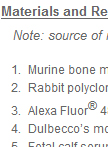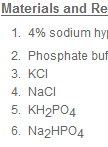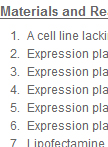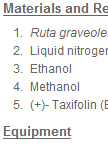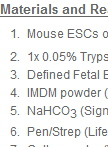Improve Research Reproducibility A Bio-protocol resource
- Protocols
- Articles and Issues
- About
- Become a Reviewer
Past Issue in 2012
Volume: 2, Issue: 22
Cancer Biology
Measurement of Hemoglobin
This protocol allows to measure the levels of intratumoral hemoglobin from human or rodent fresh samples but also frozen tumors. The advantage of this method is to use very few microliters of biological material for hemoglobin and the protocol is carried out quickly.
Measurement of Cytokines
This protocol allows to measure the levels cytokines - such as VEGFs, CXCLs cytokines, PDGF or FGF - from fresh samples but also frozen tumors. The advantage of this method is to use very few micrograms of biological material and the protocol is carried out quickly.
Cell Biology
Measurement of Free Cytosolic Calcium Concentration ([Ca2+]i) in Single CHO-K1 Cells
This is a protocol to analyze the functional response of single CHO-K1 cells to a given treatment in terms of changes in free cytosolic calcium concentration ([Ca2+]i). This is possible by using the Ca2+ indicator dye Fura-2 AM, a polyamino carboxylic acid that binds to free intracellular calcium and is excited at 340 nm and 380 nm. The ratio of the emissions at 505 nm after excitation with those wavelengths is directly correlated to the amount of intracellular calcium. This protocol can be applied to other cell types (cell lines or primary cell cultures) by changing the culture conditions accordingly to the cell type.
Immunology
Determination of Toxoplasma gondii Replication in Naïve and Activated Macrophages
Toxoplasma gondii is an obligate intracellular protozoan parasite that causes the disease toxoplasmosis. Chronic infection is established through the formation of tissue cysts predominantly in cardiac and neurologic tissues. A defining characteristic of T. gondii is its ability to evade the host’s immune defenses; specifically, T. gondii can invade and persist within host phagocytes, using them to disseminate to the brain and central nervous system where cysts are then formed. This protocol is used to evaluate the ability of Toxoplasma gondii to survive and replicate within naive and activated murine bone marrow-derived macrophages at the level of single infected cells. In the following protocol macrophages are naive or activated with IFN-γ and LPS but different activation stimuli can be utilized as well as different host cell populations and diverse inhibitors. Parasite replication is determined by evaluating the number of parasites per vacuole over time using immunofluorescence staining for parasties and microscopic analysis. Kinetic determination of parasite number per vacuole accurately reflects parasite replication over time as vacuoles-containing parasites do not fuse with one another. Isolation of murine bone marrow-derived macrophages, preparation of conditioned L929 cells for collection of macrophage colony-stimulating factor, and staining for fluorescence microscopy included in the protocol has broad applicability. This protocol works well for pathogens like Toxoplasma gondii that reside in vacuoles that do not fuse with one another and that can be visualized by microscopy.
Molecular Biology
Isolation of Epithelial Cells from Mouse Gastrointestinal Tract for Western Blot or RNA Analysis
The gastrointestinal (GI) tract is lined by a single layer of epithelial cells which function in secretion, absorption, and digestion. In addition, most GI tract tumors develop from epithelial cells (carcinomas). This protocol describes isolation of the surface epithelium from the underlying stroma, muscular layer and submucosa in the GI tract. In this protocol, epithelial cell adhesions are weekend by chelating Ca +2 ions followed by mechanical separation of the cells by vortexing. Analysis of protein levels and gene expression patterns in isolated epithelial cells versus whole GI tissue minimizes the potential for confounding contributions from contaminating stromal cells.
GPCRs Interaction Measurement by Fluorescence Resonance Energy Transfer (FRET)
This is a protocol to determine the physical interaction of a G-protein coupled receptor (GPCR) with itself (homodimerization) or with other GPCR (heterodimerazation) using fluorescence resonance energy transfer (FRET). FRET is a distance-dependent interaction between the electronic excited states of two dye molecules (in this case, CFP and YFP) in which excitation is transferred from a donor molecule (CFP) to an acceptor (YFP) molecule without emission of a photon that can be used to determine interaction among YFP- and CFP-tagged GPCRs. Nowadays, FRET microscopy technique can be used to determine interaction between any proteins that retain biological function when expressed as a fusion to the fluorescent protein.
Plant Science
Extraction of Coumarins from Leaves, Petioles, Stems and Roots of Ruta graveolens and Nicotiana benthamiana
This method describes the extraction of coumarins and furanocoumarins from leaves of Ruta graveolens (a natural furanocoumarin) producer, and Nicotiana benthamiana.
Stem Cell
Mouse ESC Differentiation to Nkx2.1+ Lung and Thyroid Progenitors
The de novo derivation of lung progenitors from pluripotent stem cells provides the opportunity to model early lung development in vitro and allows easy access to cells for tissue engineering or basic cell biology studies. This detailed protocol allows the generation of lung and thyroid progenitors from mouse embryonic stem cell (ESC) or induced pluripotent stem cell (iPSC) lines. When used together with a published Nkx2.1-GFP knock-in ESC line, the protocol allows tracking and purification of lung and thyroid progenitors by sorting on the GFP reporter based on the induction of the earliest known marker of lung and thyroid cell fate, Nkx2.1. After sorting, a pure population of Nkx2.1+ cells can then be replated for further expansion, differentiation, and maturation in culture in serum-free conditions.


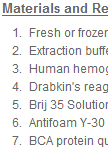
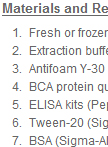
![Measurement of Free Cytosolic Calcium Concentration ([Ca2+]i) in Single CHO-K1 Cells](https://en-cdn.bio-protocol.org/imageup/arcimg/294.jpg?t=1761026289)

